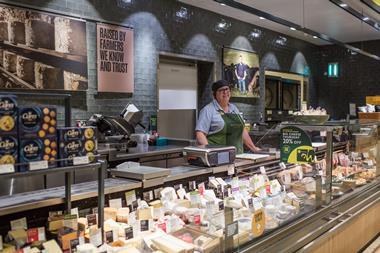The supermarkets kept inflation in check in January even as prices of fruit & veg and bakery products continued to rise in the wake of last year’s poor weather and bad harvests.
Year-on-year inflation across the multiples was just 0.9% in January, according to the latest Grocer Price Index from BrandView.com. This time last year it was 3.6%.
However, the average inflation figure disguises some sharp differences between different retailers. Facing tough competition from the discounters, Asda and Morrisons kept the tightest lid on inflation.
Asda’s inflation was just 0.2% and at Morrisons prices actually fell year-on-year, by 1.2%. This week, Kantar figures showed that Morrisons’ sales slid 1.7% in the 12 weeks to 22 January, making it the only supermarket to be experiencing falling sales.
Wholesale prices: quota dispute pushes up mackerel prices
Mackerel, fish of choice for the sustainability conscious, is having a tough time, with the Marine Conservation Society taking it off its ‘fish to eat’ last month amid the continuing dispute over mackerel quotas between the EU, Iceland and the Faroes. The uncertaintly created has started to take its toll on wholesale prices, which have risen 24.5% over the past month and are now up 12.1% on this time last year.
Norwegian farmed salmon is also up, rising 34.2% on last year and 15.1% over the past four weeks, largely because the cost of fishmeal has gone up.
Tuna is also on the rise, as supply tightens as a result of catch closures in the Indian Ocean. At £1,910/t, yellowfin is 16.2% more expensive than this time last year, despite a small drop over the past month.
An increase in the North Sea haddock quota for the EU and Norway has contributed to a 42.2% fall in wholesale prices compared with 2012, down to £758/t.
By contrast, Waitrose enjoyed sales growth of 8% over the same period [Kantar], in part thanks to its increased focus on price and promotions over the past year. Waitrose had the same inflation figure as Asda in January, of 0.2%.
Inflation at Sainsbury’s and Tesco was higher, at 2.1% and 2.6% respectively. Tesco’s inflation at a base price level, before promotions were taken into account, was even higher at 3.3%. The Tesco inflation figures sound dramatic, but the chain faced tough comparatives. A year ago, Tesco’s annual base price increases were the lowest of all the supermarkets, following its Big Price Drop campaign, which sought to reduce the pre-promotional prices of everyday items.
While average inflation was low across all the mults in January, prices went up sharply month-on-month as the annual round of festive booze promotions dried up. Alcohol prices shot up by 10% on December levels, driving a 2.1% increase in average prices month-on-month.
Outside alcohol, prices in six of the 15 categories tracked by the GPI fell month-on-month. The biggest reductions were in baby and chilled, where prices fell 5.3% and 3.4% respectively. However, there were price rises across meat & fish, bakery and fruit and veg, albeit of less than 1%. The three categories were among the worst affected by the bad harvests in 2012, both in the UK, where waterlogged fields decimated wheat, and in the US, where a drought in the Midwest hit corn crops.
The biggest impact on retail prices has been in bakery. Sharp rises in wheat prices have resulted in a 9% hike year-on-year, making it the category with the highest inflation. Even tobacco prices, hit by an increase in duty of 5% above inflation in 2012, increased by a smaller margin, of 7%.



















No comments yet